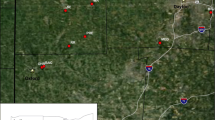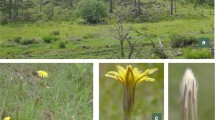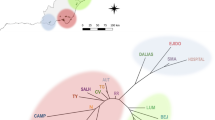Abstract
Current ex situ collections of the wild rubber tree Hevea brasiliensis were gathered more than 25 years ago mainly from populations in Southwest Amazonia. Information regarding the structure of genetic diversity among these populations is fragmented and needs refinement. Having analyzed polymorphisms at 15 microsatellites loci throughout the Hevea genome, we report on the genetic diversity of 307 clonally propagated individuals from 19 different collection points. All analyzed loci were highly polymorphic, averaging 21.7 alleles per locus, and displayed heterozygote deficiency. Differentiation among populations was analyzed on a subsample of 220 individuals from 14 populations. The overall F ST is 0.12; although low, this value is significant and suggests moderate differentiation. Mato Grosso (Brazil) populations were genetically more distant from all other populations. A highly significant correlation between genetic and geographical distances over the whole area under study was shown by the Mantel test. The Bayesian algorithm used by STRUCTURE software allowed for the identification of three population clusters that match the boundaries of hydrographical basins of the main Amazon River tributaries. Differentiation among populations could therefore be jointly explained by both geographical location within the hydrographical Amazon network and by isolation by distance among populations belonging to distinct catchments. It is likely that some of these populations no longer exist due to severe deforestation. We provide suggestions to improve genetic resource management and sampling strategy in natural populations of H. brasiliensis.



Similar content being viewed by others
References
Belkhir K, Borsa P, Chikki L, Goudet J, Bonhomme F (2000) GENETIX version 4.02. Logiciel sous Windows™ pour la génétique des populations
Besse P (1993) Identification des clones cultivés et analyse de la diversité génétique chez Hevea brasiliensis par R.F.L.P. Thèse, Université Paris XI Orsay
Besse P, Seguin M, Lebrun P, Chevallier MH, Nicolas D, Lanaud C (1994) Genetic diversity among wild and cultivated populations of Hevea brasiliensis assessed by nuclear RFLP analysis. Theor Appl Genet 88:199–207
Billington HL (1991) Effect of population size on genetic variation in a dioecious conifer. Conserv Biol 5:115–119
Bonin A, Bellemain E, Bronken Eidesen P, Pompanon F, Brochmann C, Taberlet P (2004) How to track and assess genotyping errors in population genetics studies. Mol Ecol 13:3261–3273
Bos H, McIndoe KG (1965) Breeding of Hevea for resistance against Dothidella ulei P. Henn. J Rubber Res Inst Malaya 19:98–107
Chevallier MH (1988) Genetic variability of Hevea brasiliensis germplasm using isozyme markers. J Nat Rubber Res 3:42–53
Clément-Demange A, Legnate H, Chapuset T, Pinard F, Seguin M (1998) Characterisation and use of the IRRDB germplasm in Ivory Coast and French Guyana : status in 1997. Symposium on natural rubber (Hevea brasiliensis). Volume 1. General, soils and fertilization, and breeding and selection sessions, Ho Chi Minh City, Vietnam, 14-15 October 1997. IRRDB, Brickendonbury (UK)
Clément-Demange A, Legnate H, Seguin M, Carron MP, Le Guen V, Chapuset T, Nicolas D (2001) Rubber tree. In: Charrier A, Jacquot M, Hamon S, Nicolas D (eds) Tropical plant breeding. Science, New Hampshire, pp 455–480
Collevatti RG, Grattapaglia D, Hay JD (2001) Population genetic structure of the endangered tropical tree species Caryocar brasiliense, based on variability at microsatellite loci. Mol Ecol 10:349–356
Dakin EE, Avise JC (2004) Microsatellite null alleles in parentage analysis. Heredity 93:504–509
Dean W (1987) Brazil and the struggle for rubber. Cambridge University Press, Cambridge UK
Dempster AP, Laird NM, Rubin DB (1977) Maximum Likelihood from incomplete data via the EM algorithm (with discussion). J Roy Stat Soc 39:1–38
Dijkman MJ (1951) Hevea. University of Miami Press, Miami, Thirty years of research in the Far East
El Mousadik A, Petit RJ (1996) High level of genetic differentiation for allelic richness among populations of the argan tree [Argania spinosa (L.) Skeels] endemic to Morroco. Theor Appl Genet 92:832–839
Evanno G, Regnaut S, Goudet J (2005) Detecting the number of clusters of individuals using the software STRUCTURE: a simulation study. Mol Ecol 14:2611–2620
Fearnside PM (1989) Extractive reserves in Brazilian Amazonia. Bioscience 39:387–393
Fearnside PM (2005) Deforestation in Brazilian Amazonia: history, rates and consequences. Conserv Biol 19:680–688
Ferraz SFB, Vettorazzi CA, Theobald DM, Ballester MRV (2005) Landscape dynamics of Amazonian deforestation between 1984 and 2002 in central Rondônia, Brazil: assessment and future scenarios. For Ecol Manage 204:67–83
Gonçalves PS (1981) Expedição internacional à Amazonia no território federal de Rondônia para a coleta de material botânico de seringueira Hevea brasiliensis. Embrapa - CNPSD, Manaus, pp 59 p
Goudet J (1995) FSTAT (version 1.2): a computer program to calculate F-statistics. J Hered 86:485–486
Hallé F, Combe J-C (1974) Mission en Amazonie brésilienne pour la récolte de matériel génétique nouveau destiné à l’amélioration de l’hévéa. Rapport de mission. IRCA, Paris, France, p 19p
Laurance WF, Albernaz AKM, Fearnside PM, Vasconcelos HL, Ferreira LV (2004a) Deforestation in Amazonia. Science 304:1109–1111
Laurance WF, Nascimento HEM, Laurance SG, Condit R, D’Angelo S, Andrade A (2004b) Inferred longevity of Amazonian rainforest trees based on a long-term demographic study. For Ecol Manage 190:131–143
Leconte A (1984) La reproduction sexuée de l’hévéa brasiliensis. Caoutchoucs et Plastiques 637–638:71–74
Lekawipat N, Teerawatanasuk K, Rodier-Goud M, Seguin M, Vanavichit A, Toojinda T, Tragoonrung S (2003) Genetic diversity analysis of wild germplasm and cultivated clones of Hevea brasiliensis Muell. Arg. by using microsatellite markers. J Rubber Res 6:36–47
Lemes MR, Gribel R, Proctor J, Grattapaglia D (2003) Population genetic structure of mahogany (Swietenia macrophylla King, Meliaceae), across the Brazilian Amazon, based on variation at mocrosatellite loci: implications for conservation. Mol Ecol 12:2875–2883
Lespinasse D, Rodier-Goud M, Grivet L, Leconte A, Legnate H, Seguin M (2000) A saturated genetic linkage map of rubber tree (Hevea spp.) based on RFLP, AFLP, microsatellite, and isozyme markers. Theor Appl Genet 100:127–138
Lewis PO, Zaykin D (2001) Genetic Data Analysis: computer program for the analysis of allelic data. Version 1.0 (d16c). Free program distributed by the authors over the internet from http://lewis.eeb.uconn.edu/lewishome/software.html
Lins ACR, Silva GPd, Nicolas D (1981) Report of the Acre team in joint IRRDB/Brazil germplasm expedition. Embrapa/CNPSD, Manaus, pp 24 p
Mantel N (1967) The detection of disease clustering and a generalized regression approach. Cancer Res 27:209–220
Nei M (1978) Estimation of average heterozygosity and genetic distance from a small number of individuals. Genetics 89:583–590
Nicolas D (1985) Acquisition of Hevea material derived from Colombian Schultes collections. Paper presented at International Rubber Conference 18–19 October 1985. Kuala Lumpur, Malaysia
Novick RR, Dick CW, Lemes MR, Navarro C, Caccone A, Bermingham E (2003) Genetic structure of Mesoamerican populations of Big-leaf mahogany (Swietenia macrophylla) inferred from microsatellite analysis. Mol Ecol 12:2885–2893
Ong SH, Ghani MN, Tan AM, Tan H (1983) New Hevea germplasm -its introduction and potential. Rubber Research Institute of Malaysia Planters' Conference, Kuala Lumpur, pp 3–17
Ong SH, Tan H (1987) Utilisation of Hevea genetic resources in the RRIM. Malays Appl Biol 16:145–155
Onokpise OU (2004) Natural rubber, Hevea brasiliensis (Willd. ex A. Juss.) Müll. Arg., germplasm collection in the Amazon basin, Brazil: a retrospective. Econ Bot 58:544–555
Paiva JRd (1981) Coleta de material sexuado e assexuado nos seringais nativos do Estado de Mato Grosso. Embrapa/CNPSD, Manaus, pp 26 p
Pritchard JK, Stephens M, Donnelly P (2000) Inference of population structure using multilocus genotype data. Genetics 155:945–959
Priyadarshan PM, Gonçalves PS (2003) Hevea gene pool for breeding. Genet Resour Crop Evol 50:101–114
Rands RD, Polhamus LG (1955) Progress report on the cooperative Hevea rubber development in Latin America. U.S.D.A., Washington DC, pp 79 p
Raymond M, Rousset F (1995) GENEPOP (Version 1.2) population genetics software for exact test and ecumenicism. J Hered 86:248–249
Reghu CP, Abraham ST, Nair RB, Varghese YA (2004) Performance of certain wild Hevea accessions in the early phase of further evaluation. Natural Rubber Research 17:103–107
Rosenberg NA (2004) DISTRUCT: a program for the graphical display of population structure. Mol Ecol Notes 4:137–138
Rousset F (1997) Genetic differentiation and estimation of gene flow from F-statistics under isolation by distance. Genetics 145:1219–1228
Schlötterer C, Pemberton J (1998) The use of microsatellites for genetic analysis of natural populations - a critical review. In: DeSalle R, Schierwater B (eds) Molecular approaches to ecology and evolution. Birkhaüser, Basel, pp 71–86
Scotti I, Vendramin GG, Matteotti LS, Scarponi C, Sari-Gorla M, Binelli G (2000) Postglacial recolonization routes for Picea abies K. in Italy as suggested by the analysis of sequence-characterized amplified region (SCAR) markers. Mol Ecol 9:699–708
Seguin M, Gay C, Xiong T-C, Rodier-Goud M (2001) Microsatellite markers for genome analysis of rubber tree (Hevea spp.). Paper presented at IRRDB Symposium 2001. Montpellier (France), 25-28 September 2001
Seguin M, Flori A, Legnate H, Clément-Demange A (2003) Rubber tree. In: Hamon P, Seguin M, Perrier X, Glaszmann JC (eds) Genetic diversity of tropical crops. CIRAD, Montpellier, France, pp 277–305 Science, Enfield (NH), USA
Seguin M, Attard A, Bataillon T et al (2006) Analysis of linkage disequilibrium patterns in perennial or annual, autogamous or allogamous plant species. Les Actes du BRG 57–74
Templeton AR, Shaw K, Routman E, Davis SK (1990) The genetic consequences of habitat fragmentation. Ann Mo Bot Gard 77:13–27
Turner ME, Stephens JC, Anderson WW (1982) Homozygosity and patch structure in plant populations as a result of nearest-neighbor pollination. Proc Natl Acad Sci USA 79:203–207
Walter R, Epperson BK (2004) Microsatellite analysis of spatial structure among seedlings in populations of Pinus strobus (Pinaceae). Am J Bot 91:549–557
Webster CC, Baulkwill WJ (1989) Rubber. Longman, Singapore
Weir BS, Cockerham CC (1984) Estimating F-statistics for the analysis of population structure. Evolution 38:1358–1370
Yeang HY, Chevallier MH (1992) Estimation of pollen dispersal distances in Hevea brasiliensis by esterase isoenzyme markers. 1992
Young A, Boyle T, Brown T (1996) The population genetic consequences of habitat fragmentation for plants. Trends Ecol Evol 11:413–418
Acknowledgment
Genotyping was carried out on the “Plateforme de génotypage de la Région Languedoc Roussillon” in Montpellier, France. We are grateful to Brigitte Courtois for her valuable comments on the manuscript.
Author information
Authors and Affiliations
Corresponding author
Additional information
Communicated by G. Vendramin
Rights and permissions
About this article
Cite this article
Le Guen, V., Doaré, F., Weber, C. et al. Genetic structure of Amazonian populations of Hevea brasiliensis is shaped by hydrographical network and isolation by distance. Tree Genetics & Genomes 5, 673–683 (2009). https://doi.org/10.1007/s11295-009-0218-9
Received:
Revised:
Accepted:
Published:
Issue Date:
DOI: https://doi.org/10.1007/s11295-009-0218-9




